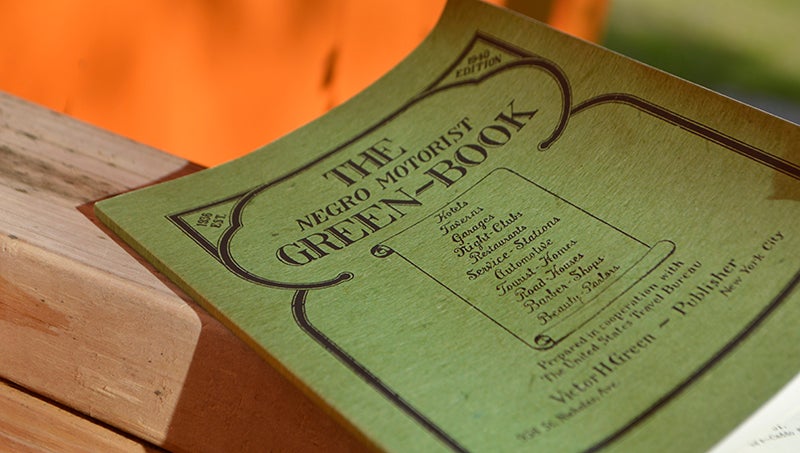Washington locales appeared in Green Book
Published 8:11 pm Tuesday, February 26, 2019

- LITTLE GREEN BOOK: A replica of the 1940 edition of the “Negro Motorist Green Book,” shows one business, Dr. Jermiah and Manilus Lloyd’s Drug Store on Gladden Street. The listing would have been used to point African-American travelers towards valuable services while traveling through the segregated United States. (Matt Debnam/Daily News)
Before this past Sunday, it’s safe to say that many Americans had probably never heard of a “Green Book,” the one-of-a-kind guidebook that helped African-American motorists navigate a segregated landscape in the era of Jim Crow, and Washington businesses were listed among its safe havens.
With the nomination and subsequent Academy Awards garnered by the film “Green Book” this past weekend, “The Negro Motorist Green Book” has been thrust into the national spotlight
Today, we take travel for granted. One can jump in the car, set off in any direction and easily find the essentials — fuel, lodging, dining, garages, points of interest — its as simple as following the informational signs on the exits. Not so for the black motorist and his family in the era of segregation. Even something as simple as finding gas or a hotel room could present a challenge.
“You find Washington starting in 1940,” Washington Waterfront Underground Railroad Museum Director Leesa Jones said. “Dr. Jermiah and Manilus Lloyd’s Drug Store was the one listed in Washington. You did have to pay to advertise, so the neat thing about it was, if one location was listed in the town, even though every business wouldn’t be listed, the one that’s listed here was in the heart of what they called ‘Little Harlem.’”
Stretching from Second to Sixth Streets on Gladden Street, “Little Harlem” would have had everything a visitor could need.
“It was affectionately called ‘Little Harlem’ by many local residents because several New York business owners had stores and restaurants here and because renown bands/singers working the ‘Chitterling Circuit’ came thru Washington and performed in the clubs and halls on Gladden Street,” Jones wrote.
In various editions of the books, three locations on Gladden Street pop out as hubs for black visitors to Washington — Lloyd’s Drug Store first appears in the 1940 edition, with Dr. William Beebe’s drug store and The StarLight Club referenced in later editions. According to Jones, as motorists came to the places listed in the books, they would have found guidance to other services in the area.
Within those blocks, Jones has identified the following black businesses and business owners in her research that would have been accessible to both locals and travelers:
- Dr. James R. Smith
- Dr. Nathaniel Dowdy — Dentist
- The I.B. Turner Library
- Agent Office for North Carolina Mutual Life Insurance
- Beauty County Agricultural Agents Vivian Morris and Aaron Solomon
- Gas/service station Owner Robert Jones
- The Hollywood Inn, owned by ‘Pomp Credle’ and The New York Cafe (travelling musicians and singers made these popular stops)
- American Legion Hall (Henry Reeves)
- Marcellus Clark Meat Market
- Payton’s Pool Room
- Leland Bowen’s Confectionery Store
- Peartree’s Grocery Store
- Joseph Barnes’ Grocery Store
- Moses Dowdy’s Grocery Store
- Thomas Pelham — Blacksmith
- Two shoe repair shops
- Four restaurants
- Three barber shops
- Four beauty parlors
- The Harlem Night Club
- The StarLight Club
- Undertaker J.G. Grimes
- Elk’s Hall
- Spring Garden Baptist Church
Within one block of Gladden Street was a black-owned dry cleaners, Maria William’s Private School and Beebe Memorial Church. Not listed as businesses were cottage industries — dressmakers, hat makers, those who used their homes as ‘Inns’ for weary travelers to rest for the night, those who made homeopathic medicines and baby sitters.
“So even though those weren’t all listed in the Green Book, if Dr. Lloyd’s office was listed, that was like the hub of the community,” Jones said.
While the “Green Book” film is not without its controversy, sparking discussions of modern day racial issues, overall, Jones believes the film has done something important — it has brought attention to a piece of history that might otherwise be forgotten.
“I always say, ‘with understanding comes knowledge,’” Jones said. “When you can understand why you needed a Green Book, it starts a conversation that we know we don’t want to go back to that, and how we keep that from ever happening again. It’s relevant because we learn from the past.”
To view the full collection of Green Books online, from 1937-1966, visit digitalcollections.nypl.org and search “Green Book.”





